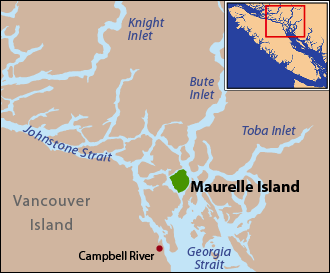Maurelle Island facts for kids

Maurelle Island is located in the middle of the Discovery Islands
|
|
| Geography | |
|---|---|
| Coordinates | 50°17′N 125°9′W / 50.283°N 125.150°W |
| Archipelago | Discovery Islands |
| Administration | |
| Province | British Columbia |
| Regional district | Strathcona |
Maurelle Island is a beautiful island found in British Columbia, Canada. It is part of a group of islands called the Discovery Islands. These islands are located between a larger island, Vancouver Island, and the mainland of British Columbia. Maurelle Island sits between two important waterways: the Strait of Georgia and Johnstone Strait.
Contents
Why is it Called Maurelle Island?
The name Maurelle Island was officially given in 1903. This was done by the Geographical Names Board of Canada. The island was named to honor a Spanish naval officer. His name was Francisco Antonio Mourelle de la Rúa. He was an explorer who sailed in the Pacific Ocean.
Where is Maurelle Island Located?
Maurelle Island is situated in a busy area of islands. It is northeast of Quadra Island. To its southeast is Sonora Island. Read Island is located to its north. All these islands are part of Electoral Area C within the Strathcona Regional District.
Waterways Around the Island
Several narrow waterways separate Maurelle Island from its neighbors:
- Calm Channel separates Maurelle Island from the mainland.
- Okisollo Channel lies between Maurelle Island and Quadra Island.
- Whiterock Passage separates Maurelle Island from Read Island.
- Hole in the Wall is a very narrow strait. It separates Maurelle Island from Sonora Island.
Surge Narrows Provincial Park
There is a special place on the southern tip of Maurelle Island. It is called Surge Narrows Provincial Park. This park is a protected area. It is known for its strong water currents.
The narrow passage between Quadra Island and the southern tip of Maurelle Island is called Surge Narrows. The water here moves very fast. These fast-moving waters are called tidal currents. They can flow at speeds of about 7.0 knots (which is about 3.6 meters per second) when they are at their strongest. This makes the area exciting for experienced boaters.
See also
 In Spanish: Isla de Maurelle para niños
In Spanish: Isla de Maurelle para niños

